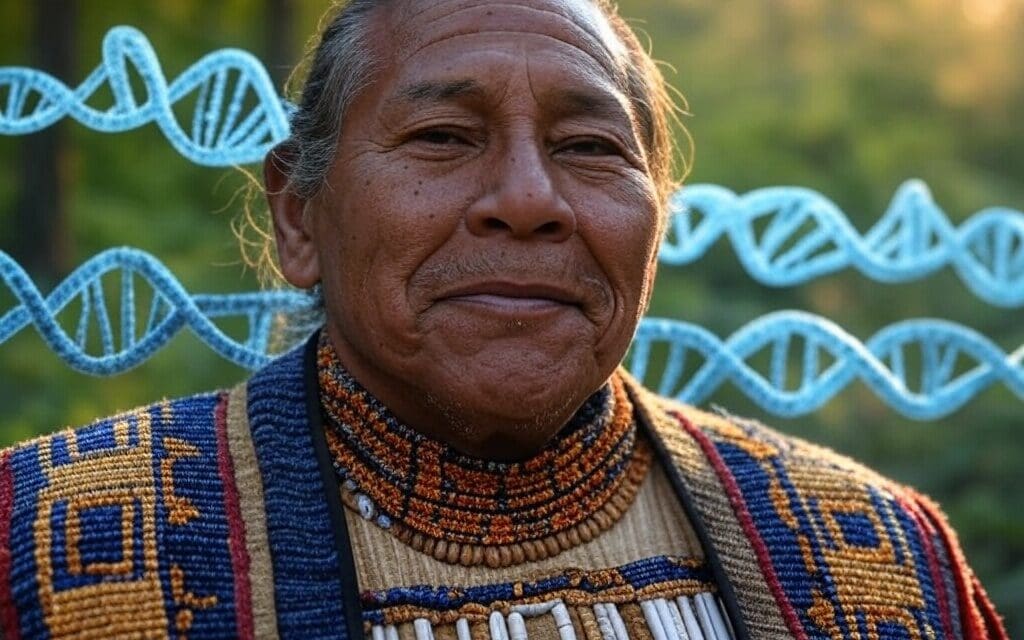No, DNA research does NOT disprove The Book of Mormon. The latest research actually points more toward confirmation and probability that a migration like that explained in The Book of Mormon happened. Critics, do better, stop being lazy and using the same arguments!
The Book of Mormon describes small groups migrating from the Middle East to the Americas around 600 BC. Recent genetic studies offer intriguing evidence that aligns with this narrative, suggesting its historical plausibility. Below, we explore the strongest arguments showing how DNA in Native American populations supports the Book of Mormon.
Haplogroup X2 in Native American Populations
The mitochondrial DNA haplogroup X2 stands out in some Native American tribes, particularly in the Great Lakes region. Unlike common haplogroups linked to East Asian origins, X2 appears in about 3–5% of populations like the Ojibwa and Sioux. Research, including studies by Perego et al. (2009), confirms X2 in pre-Columbian remains, ruling out European contact as its source. Notably, X2 is also found in Near Eastern populations, hinting at a connection to the Book of Mormon’s described origins. Its North American sub-branch, X2a, lacks a clear Asian counterpart, suggesting an independent arrival. This diversity in Native American DNA supports the possibility of a small Middle Eastern migration.
Genetic Bottlenecks and Founder Effects
Small groups, like those in the Book of Mormon, could leave subtle genetic traces that persist despite intermixing with larger populations. Historical events, such as post-European contact population declines of 50–90% (Livi-Bacci, 2006), could obscure rare markers. Yet, studies (Whyte, 2018) show that a group of 50–100 people could have their DNA survive in localized communities over 2,600 years. The presence of X2 in specific tribes suggests such a founder effect, where a small migration’s signal remains detectable. This aligns with the Book of Mormon’s narrative and counters earlier skepticism about Book of Mormon DNA evidence.
Uncertainty About Ancient Israelite DNA
Lehi’s group, from the tribe of Manasseh, lacks a defined genetic profile, as ancient Israelite DNA from 600 BC is not fully understood. Modern Jewish populations show diverse haplogroups (Feldman et al., 2019), overlapping with Near Eastern groups. Without a specific “Israelite” marker, rare Native American DNA, like X2 or autosomal signals (Adhikari et al., 2017), could reflect Manasseh’s lineage. This uncertainty supports the plausibility of the Book of Mormon, as non-Asian markers in Native populations fit within a broad Near Eastern context.
Non-Asian Markers in Specific Tribes
Certain tribes show genetic markers diverging from East Asian norms, strengthening the case for additional migrations. The Ojibwa have X2a frequencies up to 25% in some communities (Shlush et al., 2008), concentrated in areas tied to some Book of Mormon geographic models. Tribes like the Cherokee show autosomal DNA with potential Near Eastern affinity in pre-Columbian contexts (Bolnick et al., 2006). Y-chromosome haplogroup R1b, seen in groups like the Chumash, may also suggest non-Asian origins if pre-Columbian. These findings highlight genetic diversity, supporting a scenario where a small Middle Eastern group contributed to Native American ancestry.
Conclusion
The presence of haplogroup X2, the survival of rare markers despite population declines, the undefined nature of ancient Israelite DNA, and non-Asian signals in tribes like the Ojibwa all bolster the plausibility of the Book of Mormon’s migration narrative. These genetic insights suggest a small Near Eastern group could have influenced Native American ancestry, keeping the Book of Mormon’s historicity viable. For those exploring Book of Mormon DNA evidence, these findings offer a compelling case that invites further study.
Share Your Thoughts
What do you think about this DNA evidence? Join the conversation in the comments below or share this article with others interested in the Book of Mormon and Native American DNA!
The Book of Mormon describes small groups migrating from the Middle East to the Americas around 600 BC. Recent genetic studies offer intriguing evidence that aligns with this narrative, suggesting its historical plausibility. Below, we explore the strongest arguments showing how DNA in Native American populations supports the Book of Mormon.
Haplogroup X2 in Native American Populations
The mitochondrial DNA haplogroup X2 stands out in some Native American tribes, particularly in the Great Lakes region. Unlike common haplogroups linked to East Asian origins, X2 appears in about 3–5% of populations like the Ojibwa and Sioux. Research, including studies by Perego et al. (2009), confirms X2 in pre-Columbian remains, ruling out European contact as its source. Notably, X2 is also found in Near Eastern populations, hinting at a connection to the Book of Mormon’s described origins. Its North American sub-branch, X2a, lacks a clear Asian counterpart, suggesting an independent arrival. This diversity in Native American DNA supports the possibility of a small Middle Eastern migration.
Genetic Bottlenecks and Founder Effects
Small groups, like those in the Book of Mormon, could leave subtle genetic traces that persist despite intermixing with larger populations. Historical events, such as post-European contact population declines of 50–90% (Livi-Bacci, 2006), could obscure rare markers. Yet, studies (Whyte, 2018) show that a group of 50–100 people could have their DNA survive in localized communities over 2,600 years. The presence of X2 in specific tribes suggests such a founder effect, where a small migration’s signal remains detectable. This aligns with the Book of Mormon’s narrative and counters earlier skepticism about Book of Mormon DNA evidence.
Uncertainty About Ancient Israelite DNA
Lehi’s group, from the tribe of Manasseh, lacks a defined genetic profile, as ancient Israelite DNA from 600 BC is not fully understood. Modern Jewish populations show diverse haplogroups (Feldman et al., 2019), overlapping with Near Eastern groups. Without a specific “Israelite” marker, rare Native American DNA, like X2 or autosomal signals (Adhikari et al., 2017), could reflect Manasseh’s lineage. This uncertainty supports the plausibility of the Book of Mormon, as non-Asian markers in Native populations fit within a broad Near Eastern context.
Non-Asian Markers in Specific Tribes
Certain tribes show genetic markers diverging from East Asian norms, strengthening the case for additional migrations. The Ojibwa have X2a frequencies up to 25% in some communities (Shlush et al., 2008), concentrated in areas tied to some Book of Mormon geographic models. Tribes like the Cherokee show autosomal DNA with potential Near Eastern affinity in pre-Columbian contexts (Bolnick et al., 2006). Y-chromosome haplogroup R1b, seen in groups like the Chumash, may also suggest non-Asian origins if pre-Columbian. These findings highlight genetic diversity, supporting a scenario where a small Middle Eastern group contributed to Native American ancestry.
Conclusion
The presence of haplogroup X2, the survival of rare markers despite population declines, the undefined nature of ancient Israelite DNA, and non-Asian signals in tribes like the Ojibwa all bolster the plausibility of the Book of Mormon’s migration narrative. These genetic insights suggest a small Near Eastern group could have influenced Native American ancestry, keeping the Book of Mormon’s historicity viable. For those exploring Book of Mormon DNA evidence, these findings offer a compelling case that invites further study.
Share Your Thoughts
What do you think about this DNA evidence? Join the conversation in the comments below or share this article with others interested in the Book of Mormon and Native American DNA!
No, DNA research does NOT disprove The Book of Mormon. The latest research actually points more toward confirmation and probability that a migration like that explained in The Book of Mormon happened. Critics, do better, stop being lazy and using the same arguments!1.… pic.twitter.com/gukCPhyYT2— Travi𝕏 (@tkddroid) April 11, 2025






